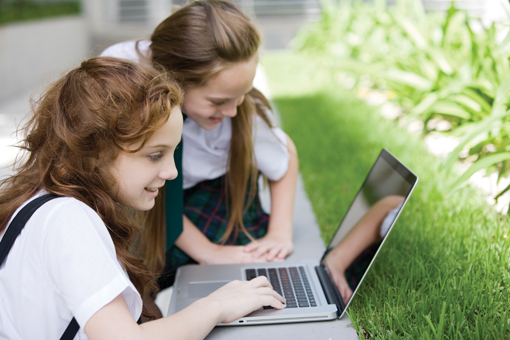Brave New Classrooms
Learning on Screen’s Schools Membership and Support Officer Lincia Daniel explores how teachers are taking advantage of a range of digital resources to make learning fun and effective.

The film Wall Street (1987) is an entertaining and thought-provoking film, arguably, about the immorality of unbridled capitalism and the peril of compromising principles of justice and fair play. It is 30 years old this year. Whenever I watch it, I’m always struck by what an amazing gadget museum it is. In the 1980s, the mobile phone, computer and fresh pasta machine featured in the film were cutting-edge but alongside today’s slim-line equivalents they look incredibly primitive.
Although the filming of Wall Street pre-dates the mass expansion of the internet, the film demonstrates how technology was changing our working lives and the way we did business even then. The impact has been equally dramatic in education where the ‘white heat of technology’ has given teachers a plethora of new digital toys for the classroom – providing new ways for education to be fun for teachers and learners. With educational resources such as on demand platform BoB learningonscreen.ac.uk/ondemand), it’s very easy for a GCSE Design Technology teacher to play a clip from Wall Street as an illustrative lesson starter before delving into a discussion on the history of technological design or, even, ergonomics.
Showing students the relevance of their studies to the real world is key to increasing student engagement…
Showing students the relevance of their studies to the real world is one of the strategies teachers adopt to boost student engagement – an essential ingredient when it comes to facilitating learning. Understanding the relevance of their course of study gives students a sense of purpose and inspires them. Unfortunately, phobias still exist about studying both art and science. Therefore, films that highlight the science in art and vice versa help to dispel barriers for students who may feel they either don’t understand art or don’t understand science.
When it comes to teaching music, BoB offers teachers access to a range of quality radio recordings covering genres from rock to pop to classical. For children grappling with practicing their instruments, performances by other children in Young Musicians of the Year, for example, or the ever popular BBC music series 10 Pieces can inspire children to keep practising to achieve their musical goals.
As 2016 was a particularly exciting anniversary year for Shakespeare we’re in the process of rolling out a new project called ‘Digital Shakespeare’. With the support of the Mercer’s Trust, we’re inviting primary and secondary schools in London to use BoB for a year in order to curate content about Shakespeare-related television and radio content.

Both the audio content and videos within BoB help teachers to enthuse their students about a particular text. At Caroline Chisholm School, Literacy Lead Katie Vince makes extensive use of audio and video in the classroom: ‘As an English teacher, I find BoB a very useful teaching tool in the classroom. I have used it for audio books (from radio programmes) for Year 8s studying Susan Hill’s The Woman in Black and the clips have worked really well, demonstrating the gothic atmosphere that students are looking out for. They find it much more engaging than reading the text aloud in class as they can hear the drama and atmosphere that the author would have wanted to create for the reader.’
Teaching a subject is one thing but teachers need to know the extent to which their students have achieved a clear and accurate understanding of principles and concepts. Ready access to moving images in the classroom has enabled teachers to use their imaginations when assessing learning as well as to teach.
Access to moving images in the classroom has enabled teachers to use their imaginations when assessing learning…
I saw one particularly inspired example during a chemistry lesson in Gladesmore School in Tottenham. The students were learning about the hydration of alkenes and had to describe the breaking of the carbon-to-carbon double bonds and the addition of hydrogen to create an alkane. The teacher had the inspired idea of playing a short animation (with the sound off) of a balanced chemical reaction and asking the children to write their own script to explain the process unfolding before them. The script-writing task engaged the children and made the science entertaining and informative. Pupils were able to read their scripts out loud as the animation played and at the end, the teacher played them the animation with the sound on. The children enjoyed the opportunity to show their understanding whilst developing the language precision needed to describe chemical reactions.
Few primary schools or home schools have their own labs where teachers can demonstrate experiments. However, the web offers a plethora of video resources that allow teachers to do the next best thing; that is to show a recording of a demonstration. One of my favourites is what I call the ‘filmmakers reaction’: – the photochemistry of silver chloride, the reaction at the heart of good old-fashioned filmmaking. Yes, Wall Street was shot on 35mm film, but I digress. Hosted by Dr N. Butyl Lithium (probably not his real name), the ‘Nurd Rage’ channel on YouTube has a range of visual chemical reactions that can enthuse children about science. At Learning on Screen, we curate educational websites like this and are constantly looking for new suggestions to share with teachers and educators, so please get in touch with your favourites.

These days, school magazines are published electronically for parents to download and just as the whiteboard has deposed the blackboard, journals or planners are fighting to hold their position as the sole repository of notes about homework. It’s very common for teachers to use applications such as Showmyhomework.co.uk to set homework. They’re able to upload detailed, written guidelines on the task to be completed, specify delivery dates, upload worksheets and embed links. Students can also submit their work by uploading it to the site where it can be accessed and marked by teachers.
Mymaths.co.uk is another popular application. The electronic demonstrations on offer make it a popular, visual aid for teaching maths. In real time, teachers can change the coefficient when plotting a straight-line graph and show students an animation that demonstrates how the gradient changes as a result. Learners can log in with student accounts, review topics and complete topic-specific worksheets online. Their results can be viewed by teachers and used to analyse the success with which learners have grasped a topic.
When it comes to BYOD (bring your own device), opinion is divided on the merits and pitfalls of allowing children to bring digital devices to school. However, they are very significant to young people and teachers have found them to be helpful tools. Mike Gunn, Head of Creative Arts and Head of Media at Finham Park School, has given talks about enhancing learning with BYOD. In his classes, children can use their phones to take photographs of their homework written on boards. Digital technology is also used to bring the outside world into the classroom and the school’s science department has set up Skype calls with NASA.
Digital technology is helping to transform education in schools. While there are great resources out there, they cannot replace the insights, enthusiasm and skills of professional teachers and it’s not within the budget of many schools to access all the technology they might wish to have. As with many things in life, it’s the quality and not the quantity that counts. If I might be so bold as to contradict Gordon Gecko, greed is not good on Wall Street or in the classroom, but a little bit of technology can work wonders.
Lincia Daniel
 Learning on Screen
Learning on Screen